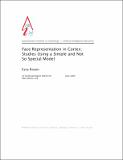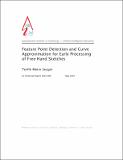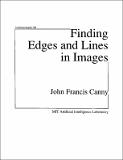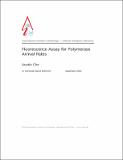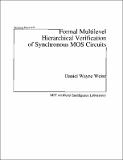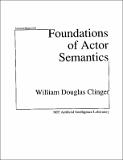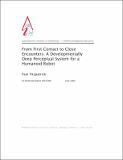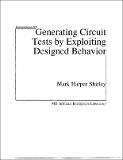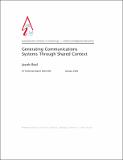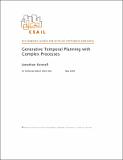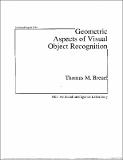Browsing AI Technical Reports (1964 - 2004) by Title
Now showing items 93-112 of 327
-
Face Representation in Cortex: Studies Using a Simple and Not So Special Model
(2003-06-05)The face inversion effect has been widely documented as an effect of the uniqueness of face processing. Using a computational model, we show that the face inversion effect is a byproduct of expertise with respect to the ... -
Fat-Tree Routing for Transit
(1990-02-01)The Transit network provides high-speed, low-latency, fault-tolerant interconnect for high-performance, multiprocessor computers. The basic connection scheme for Transit uses bidelta style, multistage networks to ... -
Feature Extraction Without Edge Detection
(1993-09-01)Information representation is a critical issue in machine vision. The representation strategy in the primitive stages of a vision system has enormous implications for the performance in subsequent stages. Existing ... -
Feature Point Detection and Curve Approximation for Early Processing of Freehand Sketches
(2001-05-01)Freehand sketching is both a natural and crucial part of design, yet is unsupported by current design automation software. We are working to combine the flexibility and ease of use of paper and pencil with the processing ... -
Finding Edges and Lines in Images
(1983-06-01)The problem of detecting intensity changes in images is canonical in vision. Edge detection operators are typically designed to optimally estimate first or second derivative over some (usually small) support. Other ... -
Finding Texture Boundaries in Images
(1987-06-01)Texture provides one cue for identifying the physical cause of an intensity edge, such as occlusion, shadow, surface orientation or reflectance change. Marr, Julesz, and others have proposed that texture is represented ... -
Flexibility and Efficiency in a Computer Program for Designing Circuits
(1977-06-01)This report is concerned with the problem of achieving flexibility (additivity, modularity) and efficiency (performance, expertise) simultaneously in one AI program. It deals with the domain of elementary electronic circuit ... -
Fluorescence Assay for Polymerase Arrival Rates
(2003-08-31)To engineer complex synthetic biological systems will require modular design, assembly, and characterization strategies. The RNA polymerase arrival rate (PAR) is defined to be the rate that RNA polymerases arrive at a ... -
Formal Multilevel Hierarchical Verification of Synchronous MOS Circuits
(1987-06-01)I have designed and implemented a system for the multilevel verification of synchronous MOS VLSI circuits. The system, called Silica Pithecus, accepts the schematic of an MOS circuit and a specification of the circuit's ... -
Foundations of Actor Semantics
(1981-05-01)The actor message-passing model of concurrent computation has inspired new ideas in the areas of knowledge-based systems, programming languages and their semantics, and computer systems architecture. The model itself ... -
From First Contact to Close Encounters: A Developmentally Deep Perceptual System for a Humanoid Robot
(2003-06-01)This thesis presents a perceptual system for a humanoid robot that integrates abilities such as object localization and recognition with the deeper developmental machinery required to forge those competences out of raw ... -
From Genetic Algorithms to Efficient Organization
(1994-05-01)The work described in this thesis began as an inquiry into the nature and use of optimization programs based on "genetic algorithms." That inquiry led, eventually, to three powerful heuristics that are broadly applicable ... -
Gait Analysis for Classification
(2003-06-26)This thesis describes a representation of gait appearance for the purpose of person identification and classification. This gait representation is based on simple localized image features such as moments extracted from ... -
Generalizing on Multiple Grounds: Performance Learning in Model-Based Technology
(1989-02-01)This thesis explores ways to augment a model-based diagnostic program with a learning component, so that it speeds up as it solves problems. Several learning components are proposed, each exploiting a different kind ... -
Generating Circuit Tests by Exploiting Designed Behavior
(1988-12-01)This thesis describes two programs for generating tests for digital circuits that exploit several kinds of expert knowledge not used by previous approaches. First, many test generation problems can be solved efficiently ... -
Generating Communications Systems Through Shared Context
(2002-01-01)In a distributed model of intelligence, peer components need to communicate with one another. I present a system which enables two agents connected by a thick twisted bundle of wires to bootstrap a simple communication ... -
Generating Compliant Motion of Objects with an Articulated Hand
(1985-06-01)The flexibility of the robot is the key to its success as a viable aid to production. Flexibility of a robot can be explained in two directions. The first is to increase the physical generality of the robot such that ... -
Generating Semantic Descriptions From Drawings of Scenes With Shadows
(1972-11-01)The research reported here concerns the principles used to automatically generate three-dimensional representations from line drawings of scenes. The computer programs involved look at scenes which consist of polyhedra ... -
Generative Temporal Planning with Complex Processes
(2004-05-18)Autonomous vehicles are increasingly being used in mission-critical applications, and robust methods are needed for controlling these inherently unreliable and complex systems. This thesis advocates the use of model-based ... -
Geometric Aspects of Visual Object Recognition
(1992-05-01)This thesis presents there important results in visual object recognition based on shape. (1) A new algorithm (RAST; Recognition by Adaptive Sudivisions of Tranformation space) is presented that has lower average-case ...

